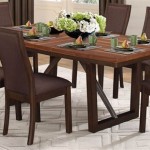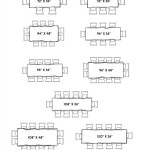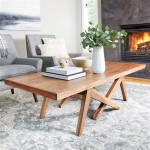Placemats For Round Dining Table: A Comprehensive Guide
Placemats are an integral part of table settings, serving both functional and aesthetic purposes. They protect the table surface from heat, spills, and scratches, while also adding a touch of style and personality to the dining experience. When selecting placemats for a round dining table, several factors must be considered to ensure a harmonious and visually appealing arrangement.
The shape of the dining table significantly influences the choice of placemat. While rectangular placemats are common, they may not be the most suitable option for a round table. Their sharp corners can create an awkward visual contrast against the circular table, disrupting the flow of the overall design. Round, oval, square, and even unique, free-form placemats offer better alternatives that complement the curvature of the table.
Beyond shape, material, size, color, and style contribute to the overall impact of placemats. Selecting the right combination of these elements will enhance the dining area's aesthetic while providing practical protection.
Choosing the Right Shape and Size
The shape of the placemat should ideally echo the shape of the dining table. Round placemats are the most obvious choice, creating a seamless and elegant look. They can be the same size as the chargers or slightly smaller depending on the desired look. Oval placemats can also work well, particularly if the round table is on the larger side, providing a little more surface area for placemat coverage. Square placemats, while less intuitive, can offer a modern and structured contrast to the roundness of the table. The key is to ensure the square placemat is not too large, overwhelming the table's surface. Consider a slightly smaller square placemat placed at an angle to soften the geometric contrast.
Size is a crucial consideration. Placemats should be large enough to accommodate a dinner plate, cutlery, and potentially a glass or bread plate, without feeling cramped. They should also leave enough exposed table surface to prevent the setting from feeling cluttered. As a general guideline, placemats should extend approximately 1-2 inches beyond the edge of the dinner plate on all sides. For round placemats, a diameter of 13-16 inches is typically suitable for standard dinner plates. Carefully measure the dinnerware being used to determine the optimal placemat size.
Free-form or uniquely shaped placemats can add a touch of personality and artistic flair to the table setting. These options often feature organic shapes and textures, creating a more relaxed and informal dining experience. However, they require careful consideration to ensure they complement the table's overall design and don't appear haphazard or out of place.
Material Considerations: Functionality and Aesthetics
The material of the placemat contributes significantly to its durability, ease of maintenance, and overall aesthetic appeal. A wide range of materials is available, each with its own unique characteristics.
Fabric placemats, such as cotton, linen, or polyester blends, offer versatility and a wide range of colors and patterns. Cotton placemats are generally affordable and easy to clean but may be prone to wrinkling. Linen placemats offer a more elegant and sophisticated look, but they require more careful ironing or steaming to maintain their appearance. Polyester blends are a practical choice, offering durability, stain resistance, and easy care. Fabric placemats can be machine washed and dried, making them ideal for everyday use.
Vinyl and PVC placemats are highly durable, water-resistant, and easy to clean. They are an excellent choice for households with children or for outdoor dining. Vinyl placemats are available in a variety of textures and patterns, including woven designs and metallic finishes. They can be easily wiped clean with a damp cloth, making them a low-maintenance option.
Wood and bamboo placemats offer a natural and rustic aesthetic. They are durable and heat-resistant, providing excellent protection for the table surface. Wood placemats may require occasional oiling to maintain their moisture content and prevent cracking. Bamboo placemats are naturally antimicrobial and resistant to stains, making them a practical and eco-friendly choice.
Cork placemats are another eco-friendly option, offering excellent heat resistance and a natural, textured look. They are also absorbent, helping to protect the table from spills. Cork placemats are relatively easy to clean with a damp cloth, but they should be protected from excessive moisture to prevent warping.
Woven placemats, such as those made from jute, seagrass, or water hyacinth, add a textural element to the table setting. They offer a natural and rustic aesthetic, but they may be more difficult to clean than other materials. Woven placemats may require spot cleaning or vacuuming to remove crumbs and debris.
Color and Style: Harmonizing with the Dining Area
The color and style of the placemats should complement the overall décor of the dining area. Consider the color of the dining table, chairs, walls, and other accessories when selecting placemats. A cohesive color palette will create a more harmonious and visually appealing space.
For a neutral or monochromatic dining area, placemats can add a pop of color and personality. Choose placemats in bold, contrasting colors to create a focal point on the table. Alternatively, placemats in subtle, complementary colors can enhance the existing décor without overwhelming the space.
For a dining area with a vibrant color scheme, consider placemats in neutral tones to balance the overall look. White, beige, gray, and black placemats can provide a clean and sophisticated backdrop for colorful dinnerware and accessories.
The style of the placemats should also align with the overall aesthetic of the dining area. For a formal dining room, consider placemats in elegant fabrics, such as linen or silk, with intricate patterns or embellishments. For a casual dining area, choose placemats in durable and easy-to-clean materials, such as cotton or vinyl, with simple designs or playful patterns.
Consider the season when choosing placemats. Opt for lighter colors and natural materials like linen or cotton for summer dining. In the fall and winter, richer colors and heavier materials like wool or velvet can create a warmer and more inviting atmosphere.
Patterned placemats can add visual interest to the table setting, but they should be chosen carefully to avoid clashing with other patterns in the room. If the dinnerware already features a bold pattern, consider placemats in a solid color or a subtle texture. If the dinnerware is plain, patterned placemats can add a touch of personality and style.
Metallic placemats, such as those in gold, silver, or copper, can add a touch of glamour and sophistication to the table setting. They are particularly well-suited for formal occasions or holiday gatherings. However, metallic placemats should be used sparingly to avoid overwhelming the space.
Ultimately, the choice of placemats for a round dining table depends on personal preference and the overall aesthetic of the dining area. By carefully considering the shape, size, material, color, and style of the placemats, one can create a table setting that is both functional and visually appealing.
Beyond the factors mentioned above, consider the maintenance requirements of different materials. Some placemats may require hand washing or dry cleaning, while others can be easily machine washed and dried. Choose placemats that fit within the lifestyle and cleaning preferences. Consider the durability and stain resistance of the material, especially if there are children or frequent spills.
Think about the texture. A smooth, sleek placemat will offer a different feel than a heavily textured one. Texture can add depth and visual interest to the table setting. Metal placemats, for example, are often associated with modern aesthetics, while woven placemats resonate with bohemian styles.
The number of placemats required will depend on how many people usually dine at the round table. It is usually advisable to have at least two extra placemats for guests. This also allows rotating placemats to ensure even wear.

Choosing Placemats For A Round Table The Art Of Placemat Selection

Placemats For Round Table Visualhunt

Nice Idea For A Round Table Setting

8pcs Gold Placemats Round Place Mat Kitchen Dining Table Wedding Decor

Round Placemats Set Of 4 Sage Green Large Placemat Cork Backed Table Mats English Luxury Dining Etsy

Handwoven Jute Round Placemats Set Of 8 Original 12

Unbranded Natural Tan 15 In Round Organic Jute Placemat Set Of 2 9874a5984d9348

Grey Velvet Round Placemats Set Of 12 For Table Decorations Mats Etsy

Rattan Placemat Round Giant Brown Alfresco Emporium

Set Of Four Artisan Woven Round Rattan Placemats








